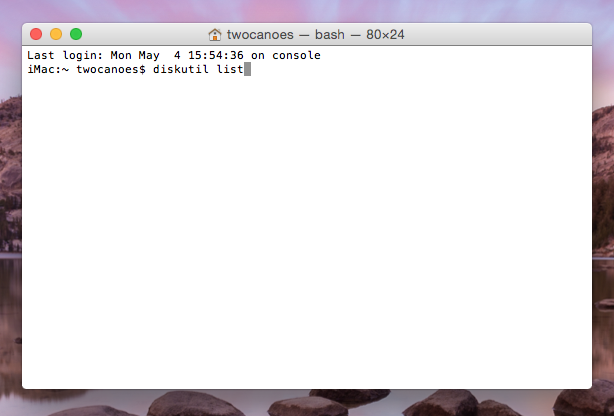
In addition to valid devices, the system contains a number of special nodes, one of which is the classic "/dev/null" device that will accept redirected text output from commands and not save it to the console, allowing for cleaner use of some commands. As with most UNIX systems, OS X accesses devices through enumerated node files located in the hidden /dev directory, and for disks these files are called "disk0," "disk1," "disk2," etc., and can be used in commands as seen above.
#PARTITION DISK MAC TERMINAL GENERATOR#
The first is to make use of the random number generator device to overwrite the drive's contents. These two command should allow you to overwrite the drive's partition scheme and allow you to set it up again as a raw device in Disk Utility however, if you still get troubles when managing the drive with these, then there are two more approaches that may work. To do this, in the Terminal run the following command, again replacing "disk1" with the identifier for your drive: The second option is to use the "gpt" command (for managing GUID partition tables) to destroy the current GUID partition table on the device. To do this, open the Terminal and run the following command (be sure to replace "disk1" with the device identifier for your specific disk-this can be looked up using the "diskutil list" command): The first of these is the "fdisk" tool, which is geared toward managing DOS-formatted drives, but can be used to initialize the drive with an MBR partition table. The disk identifiers used in commands can be found by running "diskutil list" in the Terminal, and then checking these locations in the command's output.

There are a number of third-party tools out there that can rebuild and otherwise manage a faulty drive, but Apple also supplies tools other than Disk Utility that will work. Sometimes secondary tools and approaches can at least modify the partition table enough to allow Disk Utility to overcome its hangup and work properly. If when attempting to repartition a disk you are met with "resource busy" or "cannot be unmounted" errors, first try using a different tool than Disk Utility to tackle the job.

At other times, the drive may simply be experiencing some partition table troubles or be used in ways that prevents Disk Utility from modifying the tables. Sometimes when errors like this occur, it suggests the drive may be failing however, this is not always the case. To partition and format a disk in OS X, you generally open Disk Utility, select the disk in the tool's sidebar, and click use the Partition tab to select and apply a partition scheme however, there may be times when this will not work, and Disk Utility will give you an error such as the disk cannot be unmounted, or that the resource is busy.


 0 kommentar(er)
0 kommentar(er)
